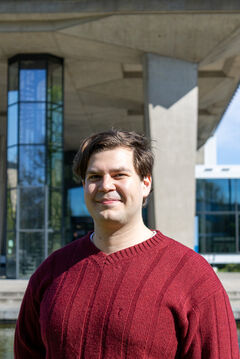
The road to valorization | HaptonTech creates haptic screens
Brand-new CEO Mert Astam gets to bring the technology to the market
Every year, numerous companies are launched to bring technological innovations developed at TU/e to society: the road to valorization. But what does that road look like? To shed light on this process, Cursor is following the newest spin-off, HaptonTech, over the course of two years. The company develops screens that can change shape in a way users can feel.
Even before coming to TU/e for his PhD, researcher Mert Astam knew he wanted to launch a startup. Now, the time has come: as CEO, he leads the latest TU/e spin-off HaptonTech. The company is on its way to developing touch-sensitive screens and haptic wearable devices that communicate through movement. For now, it is mainly focusing on applications for the visually impaired, such as a screen that can be used to read Braille and a ring that provides haptic feedback, for example, to give directions.
In his office at Helix, crammed with paperwork, Astam pulls the updated prototype – the product of decades of research – out of an ordinary plastic lunchbox sitting on his desk. “Proof that we’re really a startup,” he says with a laugh. He takes out a translucent square, two by two centimeters in size and covered in tiny dots. It’s designed as a coating for screens. The material feels smooth, but when Astam briefly places it on a hot plate, the dots are palpable. Once it has cooled down, the material is smooth again. Astam has also fashioned a ring out of it.
The prototype was made using liquid crystal technology. Astam describes it as a game of Mikado. “Our molecules are shaped like tiny rods. In their crystalline state, they all point in the same direction, like someone holding all the Mikado sticks at the beginning of the game. Once you release them, they point in all directions. Similarly, we can manipulate our molecules by activating them with heat or electricity. And what’s special about our Mikado sticks is that they can return to their original state. That is what allows the material to move.”
Generational innovation
The plan had always been to bring this new application of liquid crystal technology to market. Two generations of researchers preceded Astam. The technology was developed in the 1980s by polymer chemist and professor Dick Broer at Philips, the company where he went on to become vice president of the Research division. Broer is known for his work with liquid crystals. His innovations are used all over the world in the familiar LCDs (liquid crystal displays).
In 2015, Broer set up a research group with a 2.5-million-euro European Advanced Grant to innovate the material for practical applications, such as self-cleaning coatings for solar panels and Braille displays. Because there is much more you can do with liquid crystals – whose properties fall somewhere between solids and liquids – than just make pretty screens.
Associate professor Danqing Liu further developed the technology, initially as a postdoc in Broer’s research group and later within her own research group, Human Interactive Materials. She devised a method for linking the material to a device. “I always hoped the technology would eventually be valorized.”
A good salesman
That is when Mert Astam came into the picture. “I want to launch a startup,” he said right away during his interview with Liu for a PhD position in her Human Interactive Materials research group. Astam is originally from Turkey, lived in Romania, went to secondary school in the Netherlands, obtained his bachelor’s and master’s degrees at Imperial College London and then decided to pursue his PhD at TU/e. “In London, I saw a lot of innovative technologies being developed, but it never seemed to go anywhere. I knew about Brainport and that TU/e has brought forth a lot of startups, so that led me here.”
Astam was the first PhD candidate to obtain a doctorate under Liu’s supervision, but not the first one to start a PhD track with her. “He was the first to finish, six months before the end of his contract. Quite an achievement, considering he was also constantly helping me with all kinds of tasks. What makes him so fast is his strong writing and his smooth way of talking. He knows how to sell things.”
Still, it took Liu a while before Liu was satisfied with Astam’s performance. “He didn’t perform well in the first year. He always went for quick results, which is not a good way to do research. And he really needed to spend more time in the lab, because he had no experience with that because of the pandemic. Once I pointed that out, he quickly improved.”
Over the course of Astam’s PhD, Liu noticed increasing interest from the market in the technology, and that is why she and Dick Broer decided to set up HaptonTech. And Astam got the opportunity to lead the company. “It was good timing,” says Liu. Like Broer, she remains involved with HaptonTech in an advisory role.
Future
Before HaptonTech can enter the market, there are still plenty of technological hurdles that lie ahead. “We have to decide which product we’ll integrate the material into. That’s why I’m talking to as many potential customers as possible. We have a few concepts, such as the ring and the coating. In addition, we’re going to further develop the prototype’s electrical actuation.” It is also up to Astam to improve the prototype. “We’re currently focusing on making the material more transparent and scratch-resistant.”
Meanwhile, Astam is in the process of establishing partnerships with Audi and Lenovo, and he is continuing to explore further opportunities. In the future, he plans to expand the team with R&D capacity, business developers, industry experts, scalability experts and software engineers.
In order to make that happen, funding is needed first. Several applications for Dutch and European grants are currently pending. Astam does not need to worry about his own salary. He was recently appointed a Fellow in the NWO’s Faculty of Impact. This provides him with a personal two-year grant to turn HaptonTech into a scalable startup.
Series in the making
In addition to education and research, the university has a core duty to bring scientific output to society: valorization. Spin-offs play a key role in that process. In “The road to valorization,” Cursor is following HaptonTech for two years. In three months, a new installment will be published and we will find out more about Astam’s progress with the grant applications, the Faculty of Impact, attracting investments and the further development of the technology.





Discussion